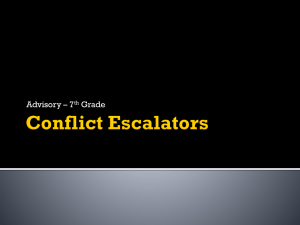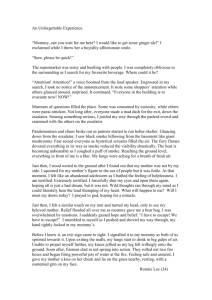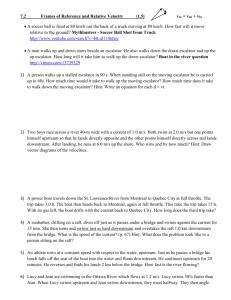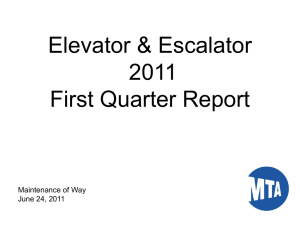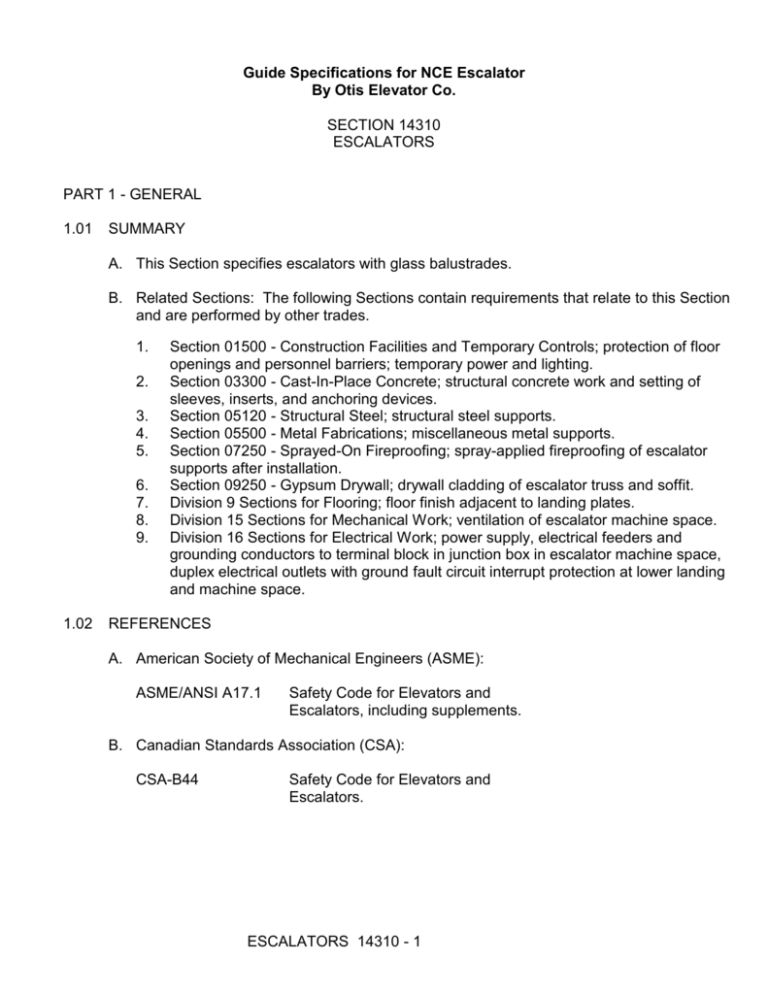
Guide Specifications for NCE Escalator
By Otis Elevator Co.
SECTION 14310
ESCALATORS
PART 1 - GENERAL
1.01
SUMMARY
A. This Section specifies escalators with glass balustrades.
B. Related Sections: The following Sections contain requirements that relate to this Section
and are performed by other trades.
1.
2.
3.
4.
5.
6.
7.
8.
9.
1.02
Section 01500 - Construction Facilities and Temporary Controls; protection of floor
openings and personnel barriers; temporary power and lighting.
Section 03300 - Cast-In-Place Concrete; structural concrete work and setting of
sleeves, inserts, and anchoring devices.
Section 05120 - Structural Steel; structural steel supports.
Section 05500 - Metal Fabrications; miscellaneous metal supports.
Section 07250 - Sprayed-On Fireproofing; spray-applied fireproofing of escalator
supports after installation.
Section 09250 - Gypsum Drywall; drywall cladding of escalator truss and soffit.
Division 9 Sections for Flooring; floor finish adjacent to landing plates.
Division 15 Sections for Mechanical Work; ventilation of escalator machine space.
Division 16 Sections for Electrical Work; power supply, electrical feeders and
grounding conductors to terminal block in junction box in escalator machine space,
duplex electrical outlets with ground fault circuit interrupt protection at lower landing
and machine space.
REFERENCES
A. American Society of Mechanical Engineers (ASME):
ASME/ANSI A17.1
Safety Code for Elevators and
Escalators, including supplements.
B. Canadian Standards Association (CSA):
CSA-B44
Safety Code for Elevators and
Escalators.
ESCALATORS 14310 - 1
1.03
SYSTEM DESCRIPTION
A. Design and Performance Requirements for Escalators:
1.04
1.
Quantity:
2.
Escalator Type:
3.
Rise:
4.
Capacity/Step Width:
9000 passengers per hour / 40”
5.
Speed:
100 feet per minute
6.
Angle of Inclination:
30 degrees
7.
Balustrades:
Extended newel type with single radius
curved decking transitions.
8.
Balustrade Color:
Clear
9.
Deck Covers:
Satin Stainless Steel, #4 Finish
Otis 508 NCE
newels and
10. Handrail Color:
Black
11. Step Demarcation:
Powder coated yellow demarcation lines
on left and right sides
12. Power Supply:
440 Volts, 3 Phase, with a separate equipment
grounding conductor.
SUBMITTALS
A. Product Data: Submit manufacturer's product data, installation instructions, and
maintenance recommendations for each material proposed for use.
B. Shop Drawings: Submit shop drawings for approval prior to fabrication. Include detailed
plans, sections, elevations and large scale details indicating escalator system and
relationship with adjacent construction. Include electrical characteristics and ventilation
requirements.
1.05
QUALITY ASSURANCE
A. Manufacturer: Provide escalators manufactured by a firm with a minimum of 10 years
experience in fabrication of escalators equivalent to those specified. Manufacturers
proposed for use, which are not named in this Section, shall submit evidence of ability to
meet performance requirements specified not less than 10 days prior to bid date, and
include a list of projects of similar design and complexity completed within the past five
years.
ESCALATORS 14310 - 2
B. Installer: Escalator(s) shall be installed by the escalator manufacturer.
C. Regulatory Requirements: Comply with the latest version of ASME/ANSI A17.1
requirements and design in response to the Americans With Disabilities Act Accessibility
Guidelines (ADAAG)
D. Pre-Installation Conference: Schedule and a pre-installation conference prior to
commencement of field operations to establish procedures to maintain suitable working
conditions and coordination with related and adjacent work.
1.06
DELIVERY, STORAGE, AND HANDLING
A. Should the building or the site not be prepared to receive the escalator equipment at the
agreed upon date, the Owner or General Contractor will be responsible to provide at their
sole cost and expense, a proper and suitable storage area on or off the premises.
Should the storage area be off site and the equipment not yet delivered, then the escalator
installer, upon notification from the Owner or General Contractor, will divert the escalator
equipment to the storage area. If the equipment has already been delivered to the site,
then the Owner or General Contractor shall transport the escalator equipment to the
storage area. The escalator equipment shall be stored and removed from storage to the
job site in a timely manner at no cost to the escalator installer.
1.07
WARRANTY
A. The escalator manufacturer and installer shall guarantee the materials and workmanship of
the apparatus furnished under these specifications and shall make good any defects which
may develop within one (1) year from date of completion of each escalator not due to
ordinary wear and tear or vandalism or improper or insufficient maintenance by others or
abuse, misuse or neglect or any other cause beyond escalator manufacturer's control.
1.08
MAINTENANCE SERVICE
A. A quality maintenance service consisting of regular examination, adjustments, and
lubrication of the escalator equipment shall be provided by the escalator contractor for a
period of twelve (12) months after the escalator has been turned over for the customer's
use. This service shall not be subcontracted but shall be performed by the escalator
contractor. All work shall be performed by competent employees during regular working
hours of regular working days and shall include emergency 24-hour call back service. This
service shall not cover adjustments, repairs or replacement of parts due to negligence,
misuse, abuse or accidents caused by persons other than the escalator contractor. Only
genuine parts and supplies as used in the manufacture and installation of the original
equipment shall be provided.
ESCALATORS 14310 - 3
PART 2 - PRODUCTS
2.01
ACCEPTABLE MANUFACTURER
A. Otis Elevator Company
2.02
EQUIPMENT AND COMPONENTS
A. Drive Machine and Brake: Worm gear type fabricated with steel worm and bronze worm
gear with roller bearings which run in oil in an oil tight housing. Mount machine within truss
and connect by chain to escalator main drive shaft. Provide electromechanical brake to
stop the escalator whenever power is interrupted, stop button is activated, or safety device
is activated.
B. Step Chain and Drive: Two strands of links, pins, bushings, and rollers connected by steel
axles to maintain proper gauging and alignment of step chain rollers. Locate rollers
between the side links of each strand. Provide rollers designed to engage driving sprockets
on main drive shaft for efficient power transmission and to support running gear on tracks.
Provide means to supply lubricant to main bearings and chains without interrupting the
operation of the escalator.
C. Motor and Controller: Electric motor integrally mounted on drive machine with adequate
starting torque manufactured for use with escalators. Provide the following:
1.
2.
3.
4.
5.
6.
Controller unit with electromagnetic switches, thermal overload relays, and provisions
to interrupt power when activated by safety devices.
NEMA Type 1 enclosure for mounting of switches and relays.
Manually operated controller lifting device attached to the controller and permanently
mounted in escalator machine space.
Class F motor insulation.
Terminal block and junction box in upper landing of escalator truss for connection to
building's 3 phase power supply.
Motor starting shall be Wye-Delta.
D. Operating Device: Momentary pressure emergency stop button and key-actuated starting
switch which shall start the escalator in either direction. Locate at upper and lower landing
newels. Provide plastic covers for stop buttons which actuate an alarm on the balustrade
when opened.
E. Moving Handrails: Reinforced synthetic rubber handrails with vulcanized joints which run
on formed guides attached to each balustrade. Provide a handrail drive designed to move
the handrail at the same speed and direction as the steps. Provide guards where handrails
enter and leave escalator newels.
ESCALATORS 14310 - 4
F. Truss: Structural steel designed to support passenger load, escalator mechanism,
balustrades, and side and soffit panel enclosure. Cladding material may not exceed 10
pounds per square foot. Provide truss which will retain running gear in its guides in event of
track system failure.
1.
Provide maintenance room inside the truss at the lower landing of adequate size to
accommodate a mechanic and allow safe performance of routine inspection and
maintenance. Access to this area is by a removable floor plate. Provide 125 VAC
duplex electrical outlets which are equipped with ground fault circuit interrupt
protection at the lower landing and in the machine space.
2.
Provide low friction material on lower landing bearing surfaces of truss when truss is
required to span an expansion joint in the building.
H. Steps and Risers: One-piece die-cast aluminum with closely-spaced cleats. Include
vertical cleats which pass between cleats of adjacent steps to provide a combing action with
minimum clearances. Provide steps which can be removed without dismantling the
balustrade.
I.
Skirt Panels: Wear-resistant , low friction powder coated material, not requiring reapplication after installation.
J.
Combs: Sectional combs located at upper and lower landings, fabricated in sections to
facilitate replacement without the use of special tools.
L. Floor Plates: Extruded aluminum floor plates matching comb plates, located over structural
steel frames at upper and lower landings and removable trap door over the machine.
M. Controller: Provide micro-processor control system with external connected service tool to
change parameters and adjustments and be prepared for remote monitoring.
If a variable frequency drive is used for sleep mode operation it has to be ensured that
energy that is generated when the escalator is operating in down direction with passengers
on the escalator will be returned back into the power grid. Variable frequency drives with
brake resistors should not be allowed.
N. Sleep Mode Operation shall comply with the following:
1. The acceleration and deceleration rates of the escalators shall not exceed
10 feet/sec2 (0.3 m/s2).
2. The rated speed is not exceeded.
3. The minimum speed of escalators shall not be less than 10 feet/min (0.5 m/s).
4. The speed of the escalator shall not automatically vary during inspection
operation mode.
5. Passenger detection means shall be provided at both landings of the escalator
such that:
a. Detection of any approaching passenger shall cause the escalator to
accelerate to, or maintain the full escalator speed in compliance with
Paragraphs 1 through 4 above.
b. Detection of any approaching passenger shall occur sufficiently in
advance of boarding to cause the escalator to attain full operational speed
ESCALATORS 14310 - 5
before a passenger walking at a typical speed of 270 feet/min (1.35 m/s)
reaches the combplate.
c. Passenger detection means shall remain active at the egress landing to
detect any passenger approaching against the direction of escalator travel
and shall cause the escalator to accelerate to full rated speed and sound
an alarm bell at the approaching landing before the passenger reaches the
combplate.
O. Passenger Detection Means:
1. Escalators shall be provided with a piezo-electric, pressure sensitive floor plate at the
upper and lower landing.
2. The device should not require any movement of the floor plate to operate.
3. The device should be pre-adjusted in the factory and not require any Field adjustment.
4. Means shall be provided to detect failure of the passenger detection means and
shall cause the escalator to operate at full rated speed only.
P. Protective Devices as Required by National Code, which include:
1. Main drive shaft brake, activated if main drive chain separates.
2. Reversal stop device, activated if direction of travel is accidentally reversed while
escalator is operating in the ascending direction.
3. Broken drive chain device, activated if main drive chain separates.
4. Broken step chain device, activated if step chain separates.
5. Skirt obstruction device, activated by object if it becomes wedged between the
step and skirt panel as step approaches upper or lower comb plates.
6. Barrier panels, located at exterior side of each balustrade at upper and lower
landings to impede access to outer deck.
7. Comb step impact device, activated by excessive vertical or horizontal force on
a comb plate.
8. Missing step device, activated by detection of a missing step and causing the
escalator to stop before the resulting gap emerges from the comb.
9. Handrail speed monitoring device, activated by deviation between handrail and
step speed of more than 15 percent; alarm shall sound; brake application if deviation
continues for more than six seconds.
10. Step level device, activated by downward displacement of riser end of step of
1/8 inch (3.2 mm) or greater; activation shall stop the escalator prior to the step
entering the combplate.
11. Handrail entry device, activated if an object becomes caught between the handrail
and the handrail guard.
12. Step upthrust device at lower landing, activated if a step is displaced against the
upthrust track at the lower curve in the passenger carrying line of the track system.
13. Wedge guards between the balustrade and adjacent structures where required by
Code.
Q. Lubrication: Provide a micro-processor controlled automatic lubrication system that ensures
the adequate lubrication of the main drive chain, handrail drive chain and step chain. The
system should work with a high-viscosity oil that will not drip off the chains and spill into the
truss and therefore also reduce the oil consumption by minimum > 50% compared to
traditional lubrication systems.
ESCALATORS 14310 - 6
PART 3 - EXECUTION
3.01
PREPARATION
A. Take field dimensions and examine conditions of substrates, supports, and other conditions
under which this work is to be performed. Do not proceed with work until unsatisfactory
conditions are corrected.
3.02
INSTALLATION
A. Strictly comply with manufacturer's installation instructions and recommendations.
B. Instruct Owner's personnel in proper operating procedures and maintenance schedule.
3.03
ADJUSTING AND CLEANING
A. Test escalators for proper operation and adjust as necessary.
B. Touch-up damaged coatings and finishes and repair minor damage.
C. Clean exposed surfaces using non-abrasive materials and methods recommended by
manufacturer of material or product being cleaned.
Notice to the user:
Permission is granted to use this material for only the purpose for which it is supplied by Otis.
2011 Otis Elevator Co.
All Rights Reserved.
ESCALATORS 14310 - 7

